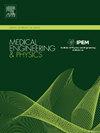Cadaveric validation of markerless tracking using weightbearing computed tomography versus conventional computed tomography imaging techniques
IF 2.3
4区 医学
Q3 ENGINEERING, BIOMEDICAL
引用次数: 0
Abstract
This study aimed to validate the use of weightbearing computed tomography against conventional computed tomography and against bead tracking for markerless tracking of key foot and ankle bones. A left cadaveric limb was implanted with tantalum beads and underwent conventional computed tomography and weightbearing computed tomography scanning, followed by biplane fluoroscopy motion capture to simulate gait. Bone models from conventional computed tomography and weightbearing computed tomography were compared for surface differences and kinematic analysis across six joints. Results showed the average surface distance difference across all weightbearing computed tomography bones were a fraction of a voxel smaller than the conventional computed tomography bones on average. Additionally, the absolute mean and standard deviation of the mean angle differences across all trials, joints, and planes was less than one degree. Weightbearing computed tomography demonstrated comparable accuracy to conventional computed tomography and to bead tracking, confirming its utility in dynamic biomechanical analysis with reduced radiation exposure and the ability to image under load. This validation supports weightbearing computed tomography's broader adoption in clinical and research settings for enhanced foot and ankle diagnostics and treatment.
使用负重计算机断层扫描与传统计算机断层扫描成像技术进行无标记跟踪的尸体验证
本研究旨在验证使用负重计算机断层扫描与传统计算机断层扫描以及无标记跟踪关键足部和踝部骨骼的磁珠跟踪之间的差异。在左侧尸体肢体上植入钽珠,进行传统计算机断层扫描和负重计算机断层扫描,然后进行双平面透视运动捕捉以模拟步态。比较了传统计算机断层扫描和负重计算机断层扫描的骨模型表面差异和六个关节的运动学分析。结果显示,所有负重计算机断层扫描骨骼的平均表面距离差异比传统计算机断层扫描骨骼平均小几分之一体素。此外,所有试验、关节和平面的平均角度差的绝对平均值和标准偏差均小于一度。负重计算机断层扫描的精确度与传统计算机断层扫描和磁珠跟踪相当,证实了其在动态生物力学分析中的实用性,同时减少了辐射暴露,并能在负荷下成像。这一验证支持了负重计算机断层扫描技术在临床和研究领域的广泛应用,以提高足踝诊断和治疗的效果。
本文章由计算机程序翻译,如有差异,请以英文原文为准。
求助全文
约1分钟内获得全文
求助全文
来源期刊

Medical Engineering & Physics
工程技术-工程:生物医学
CiteScore
4.30
自引率
4.50%
发文量
172
审稿时长
3.0 months
期刊介绍:
Medical Engineering & Physics provides a forum for the publication of the latest developments in biomedical engineering, and reflects the essential multidisciplinary nature of the subject. The journal publishes in-depth critical reviews, scientific papers and technical notes. Our focus encompasses the application of the basic principles of physics and engineering to the development of medical devices and technology, with the ultimate aim of producing improvements in the quality of health care.Topics covered include biomechanics, biomaterials, mechanobiology, rehabilitation engineering, biomedical signal processing and medical device development. Medical Engineering & Physics aims to keep both engineers and clinicians abreast of the latest applications of technology to health care.
 求助内容:
求助内容: 应助结果提醒方式:
应助结果提醒方式:


